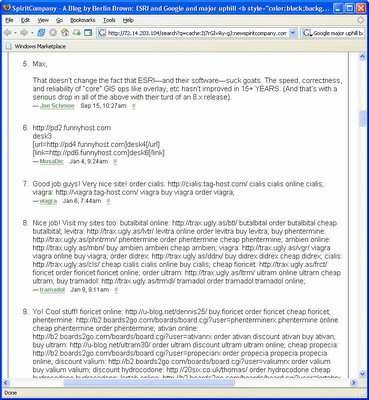Denial is Not Just a River in Egypt
Hi Chris,
Thanks for featuring me in your blog. I'm very flattered you would take the time to track down and include my picture. You don't have any actual content in your log regarding my writings that I could see (it would be good form to link to, say, a synopsis and a rebuttal), so I have no way of knowing what you agree with or disagree with. I take it that you do have some views on GIS. But if you fail to articulate those in a cogent way you do nothing but provide yet more search engine links to my writings. I've written a lot over the years so I don't know what you are getting heartburn over, but at least I have always had the respect for my readers to take the time to set forth an argument to the best of my ability at whatever level of detail was required to make my case. You may not agree with those writings, but you appear to be taking the lazy man's way out of failing to address the substance of my writings. If there is polemic in play, it is on your side and as a result of your failure to discuss the issues with whatever technical or business expertise is required to do them justice. So, if you are going to bother to cite my writings and indicate disapproval, do yourself a favor and take the time to write a rebuttal that computer professionals (or simply the intelligent general reader) can read and decide for themselves whether you have a valid point. But, if you cannot do that, I suppose I should be grateful that you would provide greater visibility for my views with whatever web of links your blog puts into play.
Regards, Dimitri
#1 This blog comments on the mores and customs of the GIS community, not the technology or application of GIS. As such, it is for people who understand that personal relationships are vitally important in business.
#2 I noticed you didn’t address the suggestion to quantify Manifold’s success in the marketplace.
#3 Your writings stand on their own and don’t require a formal rebuttal. The passage of time is sufficient to give the computer professional or even the lowly (in your mind) intelligent general reader an opportunity to evaluate their reliability. I’ll cite from your presentation to the Emergency Information Infrastructure Partnership (EIIP) in August 1998.
I figure by this time next year Manifold will be outselling (in unit volumes) all other GIS vendors combined.






